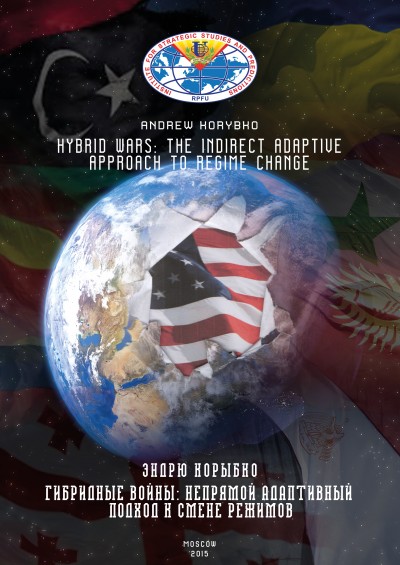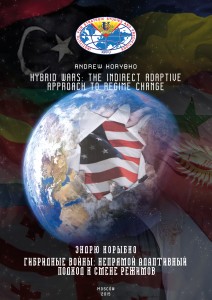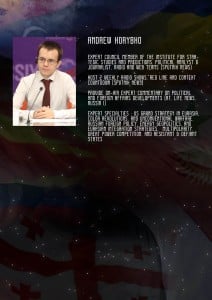Andrew Korybko: “Hybrid Wars: The Indirect Adaptive Approach To Regime Change”

“Supreme excellence consists in breaking the enemy’s resistance without fighting.” – Sun Tzu
Over two thousand years ago, the ancient Chinese military strategist realized that indirect warfare is one of the most efficient ways of fighting an enemy. It allows an opponent to defeat their adversary without directly engaging them, thereby saving themselves the resources that would have to be expended in a direct confrontation. Attacking an enemy indirectly can also bog them down and put them on the defensive, thereby making them vulnerable to other forms of attack. It also carries with it a certain opportunity cost for the defending side, since the time and resources that they spend in dealing with the indirect attack could potentially have been put to better use elsewhere. Besides the tactical advantages, there are also strategic ones as well. There may be certain constraints (e.g. alliances, military parity, etc.) that prevent one entity from directly launching hostilities against another. In this case, indirect warfare is the only option to destabilize the other.
In the current day, weapons of mass destruction and the emerging multipolar world place limits on direct confrontation between Great Powers. Even though the US still retains the world’s strongest conventional military, the nuclear parity it shares with Russia serves as a reminder that unipolarity has its limits. Additionally, the international system is morphing in such a way that the political and physical costs of waging a conventional war against certain countries (i.e. China, Iran) are becoming too much of a burden for US decision makers, thereby making this military option less attractive. Under such circumstances, indirect warfare acquires a heightened value in strategic planning and its application can take on a variety of forms.
Direct warfare in the past may have been marked by bombers and tanks, but if the pattern that the US has presently applied in Syria and Ukraine is any indication, then indirect warfare in the future will be marked by “protesters” and insurgents. Fifth columns will be formed less by secret agents and covert saboteurs and more by non-state actors that publicly behave as civilians. Social media and similar technologies will come to replace precision-guided munitions as the “surgical strike” capability of the aggressive party, and chat rooms and Facebook pages will become the new “militants’ den”. Instead of directly confronting the targets on their home turf, proxy conflicts will be waged in their near vicinity in order to destabilize their periphery. Traditional occupations may give way to coups and indirect regime change operations that are more cost effective and less politically sensitive.
Focus should be placed on the new strategy of indirect warfare that the US has demonstrated during the Syrian and Ukrainian Crises. Both situations left many wondering whether they were observing the export of Color Revolutions to the Mideast, the arrival of the Arab Spring to Europe, or perhaps some kind of Frankenstein hybrid. It is asserted that when the US’ actions in both countries are objectively compared, one can discern a new patterned approach towards regime change. This model begins by deploying a Color Revolution as a soft coup attempt, only to be followed up by a hard coup Unconventional War if the first plan fails.
Unconventional Warfare is defined in this book as any type of nonconventional (i.e. non-official military) force engaged in largely asymmetrical combat against a traditional adversary. Taken together in a two-pronged approach, Color Revolutions and Unconventional Warfare represent the two components that form the theory of Hybrid War, the new method of indirect warfare being waged by the US.
It is difficult to forecast the exact direction of Hybrid War into the future, owing to the fact that it is such a recent phenomenon and is still being constructed. Notwithstanding that, a few vague forecasts can still be made as to its worldwide implementation.
As it currently stands, the US is the only country currently engaging in Hybrid War. Russia has only tangentially recognized this new development in May 2014 at the Moscow Conference on International Security. It still does not understand what it is witnessing and is struggling to make sense of it all. The Chinese and Iranians have not officially responded to the findings of Conference, but as with Russia, they too are existentially affected by its findings. It may thus take at least half a decade for any other country to adequately understand Hybrid War to the point of being able to defend against it, let alone practice it on its own.
Hybrid War is such that it is counterproductive for any of the Eurasian Powers to attempt it in their region. This is because the creation of Black Holes of instability and chaos near their borders, no matter what the intent, would inadvertently be fulfilling the US’ grand strategic objectives. Rather, it may be that if a Eurasian Power can garner the necessary soft power and social networking ability to penetrate the societies of the Western Hemisphere, Europe, or Africa (which may likely take years to do in each case), then they could theoretically safely attempt Hybrid War without fear of any negative blowback to their interests. Nonetheless, it still remains to be seen whether these necessary intangible preconditions can be created outside of the civilizational space of each Eurasian Power, thereby strongly decreasing the likelihood that they will practice Hybrid War within the next decade or two, if at all.
The aim of the book is to prove the existence of Hybrid War, the indirect adaptive approach to regime change that combines Color Revolutions and Unconventional Warfare into a unified strategy. Geopolitics dictates US strategy in this regard and identifies future targets, while Hybrid War tactically carries out the plans and unleashes weaponized chaos. It abides by several primary military theories in order to result in the dominance of chaotic dynamics. Effective information outreach campaigns and the construction of social networks over a period of time can lead to the development of a hive mind of anti-government activists. These individuals can then be guided via the teachings of Gene Sharp into strategic swarms that work to overwhelm the authorities and initiate a soft coup. Should the Color Revolution fail in overthrowing the government, then the transition to Unconventional Warfare occurs, whereby the social infrastructure of the Color Revolution becomes the foundation of the violent campaign being waged by the anti-government movement. It is at this point that the hard coup commences and all elements of the state are thrown into strategically engineered chaos.
As has been argued, Hybrid War is the new horizon of US regime change strategy. It incubates the US from the political and military risks associated with direct intervention and it is much more cost-efficient. It indirectly uses a hodgepodge of proxy groups to accomplish for Washington what half a million US soldiers may not be able to directly do. It is thus extremely attractive to American decision makers as their country reluctantly lurches towards multipolarity, and the successful multi-theater implementation of Hybrid War could actually reverse this process and refresh the unipolar moment for an undetermined amount of time. Therefore, it is conclusively in the interests of multipolar-oriented states to master their understanding of Hybrid War in order to effectively craft strategies to neutralize its successful application across the Eurasian supercontinent and prevent the return of unipolarity.
“HYBRID WARS” PRESS RELEASE FROM SPUTNIK INTERNATIONAL’S ANDREW KORYBKO
Sputnik International’s political analyst and journalist, Andrew Korybko, just published his first book on “Hybrid Wars: The Indirect Adaptive Approach To Regime Change”. It was reviewed by the Diplomatic Academy of Russia and released with the assistance of the People’s Friendship University of Russia, where Andrew is a member of the expert council for the Institute of Strategic Research and Predictions. His detailed work proves that Color Revolutions are a new form of warfare engineered by the US, with everything from their organizational makeup to geopolitical application being guided by American strategists. But unlike earlier researchers who have touched upon the topic, Andrew takes his work even further and uses the latest examples of the War on Syria and EuroMaidan to argue that the US has deployed a second, more dangerous step to its regime change toolkit.
Hybrid Wars, as he labels them, are when the US meshes its Color Revolution and Unconventional Warfare strategies together to create a unified toolkit for carrying out regime change in targeted states. When a Color Revolution attempt fails, as it miserably did in Syria in 2011, the backup plan is to roll out an Unconventional War that builds directly upon the former’s social infrastructure and organizing methods. In the case of EuroMaidan, Andrew cites Western news sources such as Newsweek magazine, the Guardian, and Reuters in reminding everyone that in the days immediately prior to the coup’s successful completion, Western Ukraine was in full-scale rebellion against the central government and the stage was set for an Unconventional Syrian-esque War in the heart of Eastern Europe. Had it not been for the sudden overthrow of President Yanukovich, the US was prepared to take the country down the path of the Syrian scenario, which would have been its second full-fledged application of Hybrid War.
Andrew’s revolutionary research ultimately shows that it was the US, not Russia, which spearheaded the use of Hybrid Wars, and that given his proven findings, it’s irresponsible to even call Russia’s alleged involvement in the Ukrainian Crisis a ‘hybrid war’. In fact, the US is far ahead of any other country in practicing this new method of warfare, as no other state has attempted a Color Revolution thus far, let alone transitioned it into an Unconventional War when their initial regime change plans failed. While some many think that such occurrences are spontaneous and happenstance, Andrew documents how Hybrid Wars are not only created from the ground-up by the US, but how they’re specifically deployed in areas where they’d be most geostrategically advantageous for the promotion of its unipolar policies.
Thus, not only does Andrew describe the very essence of Hybrid Wars, but the final part of his book forecasts where he believes they may happen next. He introduces the groundbreaking concept of the Color Arc, a contiguous line of states stretching from Hungary to Kyrgyzstan and where the waging of Hybrid Wars would most seriously damage Russia’s national interests. This is the first time that Color Revolutions have ever been analyzed through a geopolitical prism, and it brings forth a completely different way of looking at this weapon’s utilization. This new paradigm is absolutely essential for understanding the US’ new approach to regime change and the form, both physical and geopolitical, it’s expected to take in the forthcoming years.
“Hybrid Wars: The Indirect Adaptive Approach To Regime Change”
will be available on 17 August for free PDF download at Fort Russ (fortruss.blogspot.com), Center for Research on Globalization (globalresearch.org), Oriental Review (orientalreview.org), and Center for Syncretic Studies (syncreticstudies.com), and can be picked up in soft cover form at the People’s Friendship University in Moscow.
As he’s offering his work for free, Andrew kindly asks that readers who are pleased with it to consider donating to charity and individual efforts that directly assist the victims of the US’ Hybrid Wars on Syria and Ukraine.
He hopes that your generous donation can help make their American-inflicted suffering more manageable.



